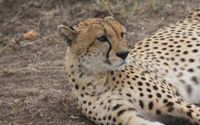LIFE AND DEATH ON THE MASAI MARA
LIFE AND DEATH ON THE MASAI MARA.
By CHANTAL COOKE.
Dozens of bodies float down the river, forming huge islands of death as they get caught on the rocks and other debris.
Crocodiles, fat from gorging on the rotting flesh, sit back and watch as Marabou Storks and Vultures peck away at the meat. There’s enough for everyone and no need to fight for your supper.
This is the Masai Mara during the migration season, when 1.8 million wildebeest make the annual circuit from the Serengeti to the Mara in search of food. 250,000 of them won’t survive. Instead they will end up as food for hungry predators and scavengers.
But this is one of the reasons why visiting the Masai Mara between July and October is such an amazing spectacle. During this time millions of animals call this area home and it’s impossible not to be over whelmed by the sheer numbers.
Whether you are picking your way carefully through 100,000 wildebeest, listening to the chorus of grunts as they kick up the dust under their hooves or smiling at the incongruous sight of a hyena sitting half in and half out of a mud pool in an attempt to cool its digestive system, these are experiences and memories you’ll treasure.
Listening to hippos snorting as they wallow in slimy pools, marvelling at the mating dance of the male ostrich, gasping with delight at your first site of a pride of lions, and feeling your heart melt as you watch a tiny baby elephant try to keep up with its mother; these, and many more, are the reasons why so many tourists make the trek to the Masai Mara each year.
With a good guide and a sturdy vehicle you’re also likely to see cheetahs, buffaloes, zebras, storks, mongoose and eagles, as well as a varied selection of hoofed animals from Thomson’s gazelle and the topi to impala and eland. If you’re lucky, you might even see a jackal.
You’ll need at least three days (two nights) to get any sense of the Masai Mara, but if you can spare longer – you won’t be disappointed.
There are lots of camps and lodges to choose from. For example, Olumara Camp provides luxurious accommodation at a reasonable price. The setting is natural and feels in-keeping with the surrounding area. To access the camp you cross over the river via a rope bridge that adds to its authentic ‘bush feel’. The food is good and the tented rooms are comfortable.
The number of people visiting the Masai Mara each year is a double-edged sword. It’s certainly providing work and an income for many, and the more responsible outfits have close links with the local community ensuring that money stays with the local people.
But on the other hand, many new buildings are springing up around the edge of the park and the large number of safari vehicles trundling across the savannah each day adds pollution to the air, erosion to the ground and disturbance to the animals.
So be sure to book with a responsible operator, who can clearly show you what they are contributing locally and how they are mitigating their environmental impact.
About the Author
Chantal Cooke is an award winning journalist and broadcaster.

